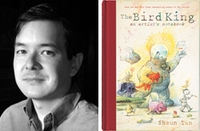With this haunting, wordless sequence about a lonely emigrant in a bewildering city, Tan (The Lost Thing
) finds in the graphic novel format an ideal outlet for his sublime imagination. Via pencil illustrations that resemble sepia photographs or film cels, Tan depicts a man’s poignant departure from his wife and daughter. Stark stone houses, treeless streets and rustic kitchen appliances imply past eras—the man leaves home via an outmoded locomotive and steamship—but strange visuals reveal this is not our everyday world. Shadowy dragon tails trawl the sky of the man’s homeland, suggesting pogrom or famine, and when he arrives at an Ellis Island-style port (the endpapers depict passport photos of multicultural travelers), his documents are stamped with cryptic symbols. He gets aboard an unmanned hot-air balloon that delivers him to a vast metropolis with unfamiliar customs and bizarre technologies (imagine, perhaps, a Gehry-designed city). Tan offers no written explanations on this foreign space, so readers fully grasp the man’s confusion when he lands a job pasting posters, then hangs them upside-down until his employer corrects him. Readers also understand his empathy for other exiles (each with their tragic stories of immigration) and with a friendly family that invites him to a meal of the local produce, which resembles exotic anemonae. In an oddly charming touch, each person has a distinctive animal companion, reminiscent of Philip Pullman’s daemons or Hieronymus Bosch’s alchemical creations. The man receives his own creature, a creepy-cute white monster with an egg-shaped torso, huge mouth and waving, eel-like tail; initially repulsed, he slowly warms to its amiable disposition. Just as gradually, his melancholy gives way to optimism and community as, despite setbacks, he benefits from the kindness of strangers. Tan adeptly controls the book’s pacing and rhythm by alternating a gridlike layout of small panels, which move the action forward, with stirring single- and double-page spreads that invite awestruck pauses. By flawlessly developing nuances of human feeling and establishing the enigmatic setting, he compassionately describes an immigrant’s dilemma. Nearly all readers will be able to relate—either through personal or ancestral experience—to the difficulties of starting over, be it in another country, city, or community. And few will remain unaffected by this timeless stunner. Ages 12-up. (Oct.)


